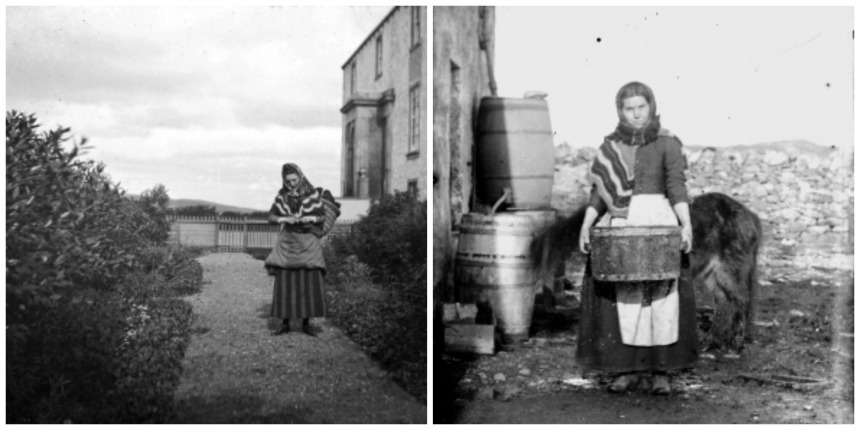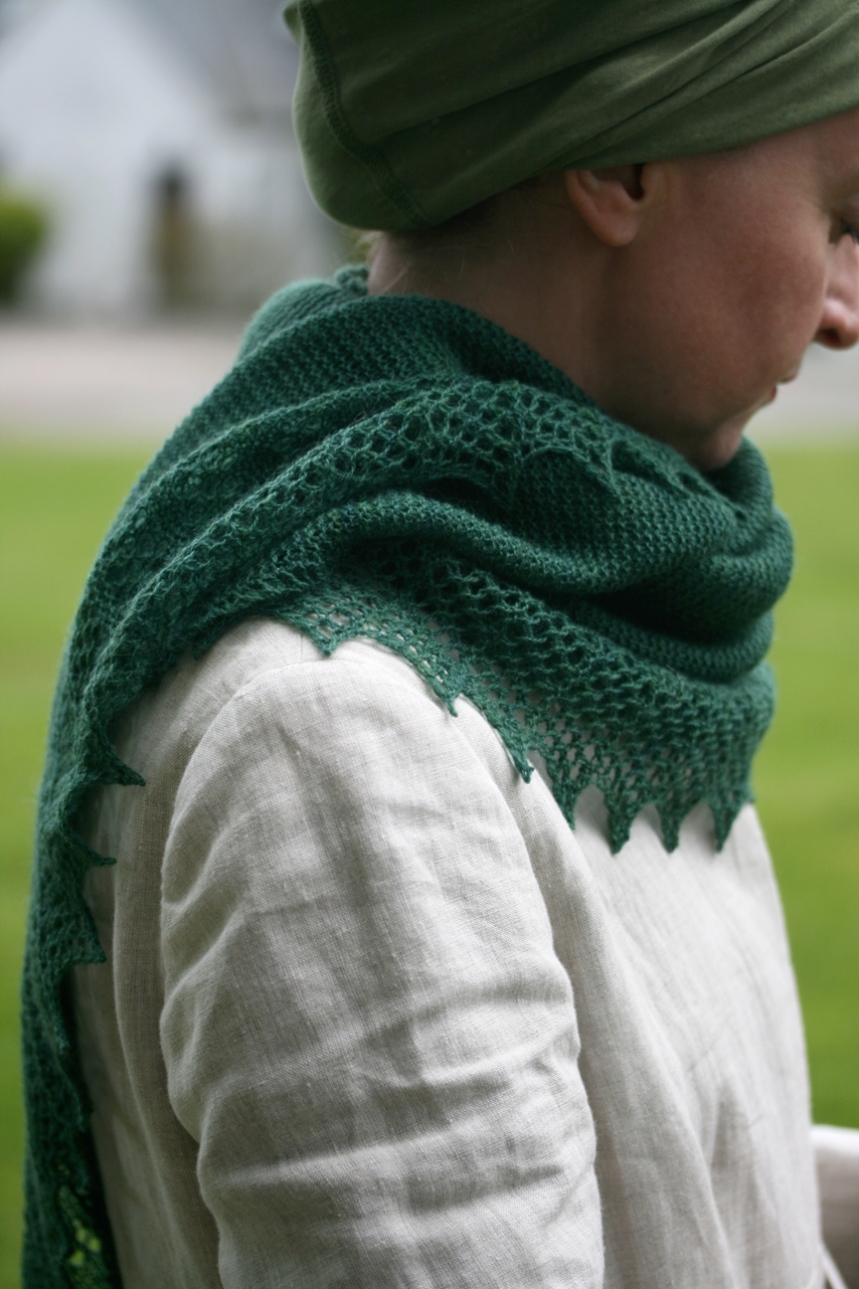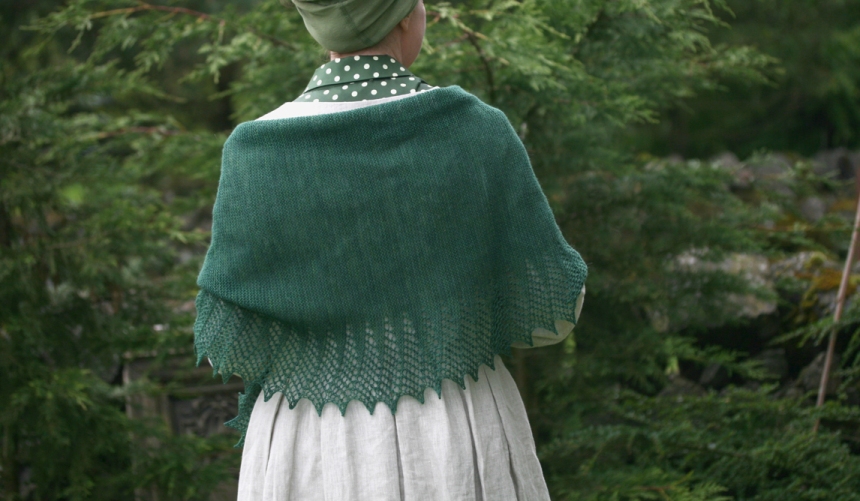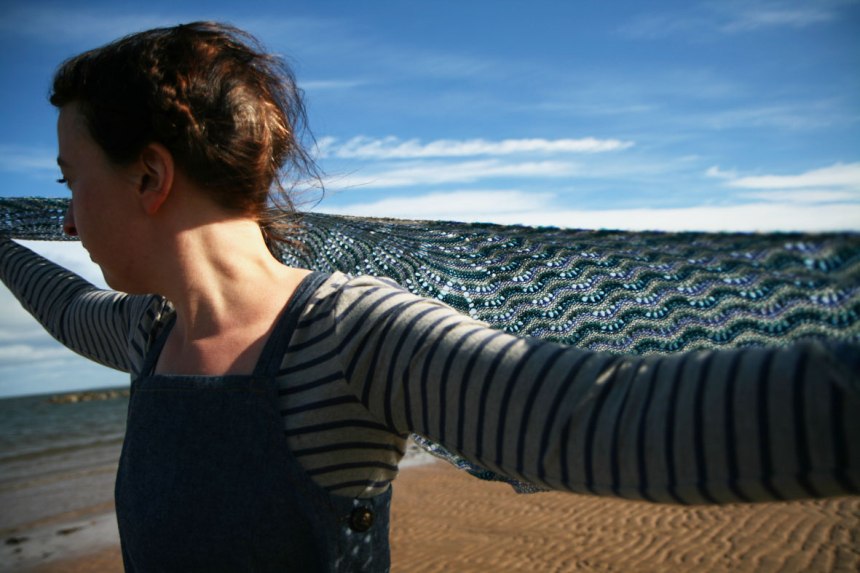
(image courtesy Shetland Museum and Archives)
I am a great fan of haps (which form the focus of one of my long-term projects) and I’m very happ-y indeed to see increasing interest in these simple and timeless shawls: Gudrun has a wonderful Craftsy class on haps, and has been running a knit-along for her full and half hap patterns for a couple of months. And, yesterday, led by Louise from Knit British, the much-anticipated hap-along began!
Several participants in the hap-along are knitting either my Northmavine Hap (above), or my Hap for Harriet (below) and I wanted to say a few words about these designs.
These patterns are inspired by, and share elements of ‘traditional’ Shetland haps: they are worked over a garter stitch fabric; are knitted in a “heavy” rather than a “fine” Shetland wool yarn; and feature simple Shetland openwork patterns, rather than fine lace. Their construction, however, is rather different from the borders-in, or centre-out method used by Shetland knitters to create a hap: Northmavine is a top-down, centre-out design, and Hap for Harriet is worked from side to side with some simple shaping and openwork to create its sweeping points.
My understanding of the word “hap” is as a simple wrap or covering – a word that has been used in Scotland and Northern England for centuries to convey the idea of cosiness and warmth. I wrote about the etymology of “hap” in Colours of Shetland thus:
“As knitters, we may have come across the word “hap” in reference to Shetland (or Shetland-type) shawls featuring simple openwork, but what precisely does it mean? “Hap” is a word common to Scots and Northern English dialects, as well as Shetland, and means to wrap, to cover, or conceal. From the 14th century on, the word “hap” crops up frequently in a wide variety of Northern texts, its usage ranging from the quotidian (the protection of crops in cold ground, the repair of a thatched roof) to the sombre (the wrapping of a corpse or the burying of a secret). In Scots, to be “weel happit” means to be well wrapped-up against the cold, and, it is perhaps in reference to colder winter weather that the word has been most often used. In The Brigs of Ayr (1786) for example, Robert Burns summed up the time of year as “when the stacks get on their winter haps”, and James Hogg memorably captured the atmosphere of a chilly evening: “When gloamin o’er the Welkin steals / And haps the hills in sober grey” (Forest Minstrel, 1810). More recently, ‘hap’ appears as a singularly Wintery covering in Edinburgh author, James King Annand’s lovely poem, Purple Saxifrage (1991).
Aneath a hap o snaw it derns
Deep in a dwam for maist the year
To burst throu in a bleeze o starns
Syne skail its flourish on the stour.
(Anglicised:
Beneath a hap of snow it hides
Deep in a dream for most the year
To burst through in a blaze of stars
Then spill its flourish on the storm)
When the weather is chilly, what better way to be “weel happit” than in a warm and cosy wool shawl? While, in 19th-century mainland Scotland, the noun “hap” might suggest a plaid or other type of women’s wrap, in Shetland a “hap” came specifically to refer to the attractive openwork coverings made and worn by the knitters of those islands. In contrast to the luxurious fine lace shawls that were produced for merchants or special occasions, haps were intended for everyday use, to be worn around the house or on the hill. Spun and knitted thicker than fine lace, a hap was a garment with a function: to keep the body warm. Wrapped and tied around the torso, or tucked hood-like around the neck and chin, a good hap would efficiently insulate its Shetland wearer against the exigencies of cold and wind. Knitted over a background of garter stitch, and featuring shaded chevrons of familiar Shetland openwork patterns (first in natural sheep-shades, and later in dyed colours), haps could also be incredibly beautiful and striking in their simplicity. Like the best kind of functional clothing, haps possess a certain timelessness of design, and today this Shetland classic is frequently re-interpreted by knitters around the world.”
Colours of Shetland, 2012, p.52-3
I think it is their functional quality – coupled with a certain elegant simplicity – that make haps appeal to me so much as both a designer and a knitter. These are garments to be made and worn. They are relaxing to knit, add colour and warmth to our outfits, and have a certain timeless ease which to me suggests the importance and longevity of the simple shawl in women’s wardrobes. Because of this, the Northmavine Hap and the Hap for Harriet are among my favourite designs, and if you are making either in the hap-along I do hope you enjoy the patterns!

(Hap for Harriet in Old Maiden Aunt Shetland 2ply)
(Northmavine Hap in Jamieson and Smith 2 ply Jumper Weight)
Thanks so much for all your good wishes over the past couple of weeks. I really have been quite unwell, and because of this somewhat grumpy – hence the silence here. As you might imagine, it can take me a while to recover from what to most folk is a routine infection, and I find this really frustrating, but am happily regaining my energy now. If you are waiting for an email response to a customer service query I promise I’ll get back to you soon!






Got two North Ronaldsay haps here, one moorit, one white, knitted in about 1920, handspun by Sarah Muir. I love haps, just been given one by my daughter. Glad you are better! X
LikeLike
The first B&W photos of you are a bit blurry. I didn’t know you had a pony! ;oP
Interesting post, nice work too.
LikeLike
Hi Kate,
I’m glad to hear that you’re getting better, and I sympathise with feeling that something minor is taking too long to recover from – I’ve had a number of stomach bugs in the last six months and the last one (this weekend just gone) has completely wiped me out. (I was only ill for about 12 hours, but I haven’t found the energy to leave the house yet.)
I too would be very hap-py if you wrote a book of haps. I’d never heard of them before I started following your blog; ‘A Hap for Harriet’ was one of the first posts I read, and the pattern went straight on to my ‘want to knit’ list. As people have said above, it is beautiful in its simplicity. (I also adore the shade of green it’s knitted in, in the photos.)
I’m now wondering if ‘hap’ is related to the term ‘lap’ as used where I grew up in West Yorkshire, which means the same thing (to wrap up)., e.g. “Lap thissen up, it’s cold out.” I don’t know enough about either dialect, but I can imagine the word changing with the different accents as it moved further south.
Thank you again for writing such an interesting and inspiring blog.
LikeLike
These are beautiful – I’d not heard of haps before but I think I ought to try to make one.
I recently discovered that “haps” is the Danish onomatopoeia for a sort of snap like an alligator :)
Hope you’re well happit to help you recover.
LikeLike
Lovely you are improving. I have a North Ronaldsay hap in natural colours handspun in about 1920, plus a white NR shawl of the same vintage. Love haps. Just been given one knitted by a knitter in Norfolk, what a treasure. Keep smiling! Christine in North Ronaldsay.
LikeLike
Glad to see you are up and about! I always love dropping in here to learning about something new. I am not a Hap person but I do love the idea may be one day I will try to knit one up!
LikeLike
So very happy to see a post and am very glad you are on the mend! And I truly enjoy reading your fantastic writing – I learn so much! I’ll enjoy so much more the knitting of both the haps now :)
LikeLike
Greetings Kate, I am doing the hapalong with a version of NorthMavine. I am using stash and working back and forth between fingering and sport/DK weights. As an eternally restless and non-systematic individual I am changing color arrangements and colors as I move along. So far I’m pleased and intrigued. I’ll try to post images somewhere along the way with this international KAL.
Get well soon and thanks for the wonderful poems (with translations).
Gail
LikeLike
It’s nice to see you again. I hope you are feeling better soon.
LikeLike
Hello Kate, I’m on my third Hap for Harriet and keep looking around my stash thinking what can I use for the next one? Truly one of my favorite designs.
I’m glad you are feeling better!
LikeLike
Dear Kate, so pleased to hear you are on the mend.
I completed my Northmavine Hap last week and as winter approaches here am looking forward to wearing it. I bought the wool at J&S when on holiday in Lerwick las year. Ella kindly mailed it back to Australia for me. Now about to start Scatness.
I also have problems posting comments on your site. Hopefully this time it will come up.
LikeLike
Glad you are on the mend, Kate! I love haps too, thanks for sharing :)
Nin
LikeLike
Thank you for this lovely post! I am glad to hear you are feeling better!
LikeLike
Good evening from New York to you Kate.
Earlier today, I left you a longish comment about haps, and praising both your Hap for Harriet and Gudruns’s Halligarth. It looks as if that comment sort of disappeared.
Perhaps it will resurface. Meanwhile, I do hope that you continue to feel better and thank you so much for your marvelous posts that inform and inspirer us.
xo Frances
LikeLike
Glad to hear you are on the mend. With winter approaching here I am looking forward to wearing my Northmavine hap, finished last weekend. It would have been fun to join a KAL but no matter, I loved the rhythm of the knitting. Used J&S which I purchased in Lerwick when on holiday last year. I arrived with a list of wool required to knit your patterns which Ella was quick to put together for me and mail back to Australia. Next on the list is Scatness.
LikeLike
Glad to hear you are on the mend and thank you for reminding me of the word “skail” in the poem you quoted. Skail is a word we used frequently in my childhood and one I never hear used these days.
Hope your health continues to improve.
LikeLike
Kate, I’m so glad you are back in the land of the living. I have never met you, more am I likely to, but you figure large in my life. I knit and you inspire Mr, I live in a lovely part of Both Yorkshire but all our precious spare time is spent not far from you in Scotland. On my daily commute by bus to work for the NHS I knit, often one of your inspirational patterns. You help makewhat is important to me.
LikeLike
The joys of predictive text and a glass of red wine!! Dropped a few stitches last night as well. I knitted your hap from colours of Shetland for a much loved friend, now sadly no longer with us. Each garment has its own back story to everyone who knits.
LikeLike
Kate, I consider it a good day indeed any time I learn something new. Thank you for the enlightenment on the word ‘hap’! It now makes the meaning of the word hapless even more clear and picturesque. Not only is the hapless person unlucky, but they’re uncovered, cold, and miserable (and possibly shamed) as well!
LikeLike
Ah yes, the history. I am spinning a Ryeland fleece, from Shankend Farm in the Borders, and it will be for the Hap for Harriet, in lace weight. I am very excited re this project. Stay well, thinking of you!
LikeLike
Glad you are on the mend. I totally understand being grumpy when not feeling well may you stay healthy. I took the class from Gudrun and I love the construction.
LikeLike
I’m glad to see that if you’re blogging again that you must be feeling better. Loved learning more about the haps, both language-wise & usage. Spring is a good season for haps as the temperatures fluctuate on their way to warmth. Keep well happed.
LikeLike
Bright spot in the day when I find your post. Your ability to place a hap in context with language and history changes a bit of knitting to connection. Thanks
LikeLike
I am glad you are doing better, Kate! Your Hap for Harriet is so lovely – simple, elegant and very feminine! I have to put it on my must-make list!
LikeLike
I’ve joined in the Knit British Hapalong, so thank you for your timely post, Kate. Your Northmavine Hap was my first ever hap, and I am partway through my Hap for Harriet. I’m glad to hear you are feeling better.
LikeLike
What a lovely post! I really enjoy the information you share. Thanks.
LikeLike
Selfishly, it is so good to have you back. However, please take good care, thst is the most important thing. Love rhese Haps.
LikeLike
Great to hear that you are well on the road to recovery. I am still knitting my” Hap for Harriet”
LikeLike
Glad you are feeling better, Kate. I too have missed your blogs
LikeLike
Soooo glad you’re feeling better! It was a joy to receive this post after a few quiet weeks :)
LikeLike
I love the way these words are being ‘saved’ from extinction. Our language is so rich and diverse, we are so lucky to be able to enjoy and revel in it.
You are doing your (not insubstantial) bit to keep our language alive.
LikeLike
HEY Kate, it is such a coincidence, one week ago I started knitting your Northmavine shawl for my mother, who, when she saw it in Colours of Shetland, said is is the most beautiful shawl she had ever seen. And I am also finishing a shawl with Sethlands organic wool, 1 ply with catś paw and old shale patterns…
LikeLike
So happ-y you’re on the mend. I know you’ll take good care. I notice in my Facebook Shetland groups all shawls, including what I would call fine lace, are called warm shawls, or happs. I love the down to earth, unpretentious feel of this.
LikeLike
I’ve been participating in the hap-along and it’s been great fun. I’m using one of Gudrun’s patterns however, in preparing for the KAL I found so many different patterns to love that my Ravelry queue grew by 5 or 6. What is it about a garter base and decorative edge that is just so darn addicting? I think you hit on a number of the attractive qualities above: functional, simply, elegant, comforting. A number of people commented on the chat thread for the KAL that they had never been so excited about a simple knit-along before.
LikeLike
It is the first time I write here, but I read from a long time now and I love everything you write, since is so well written and so interesting. I hope you feel well, and I am happy to say that I knitted these two models already! Love them both.
LikeLike
Fascinating. Love haps and spencers, which are not terribly far away in stitch pattern terms! Keep going, the good weather is nearly here. There have been some nasties around this year, like the mutant flu that the whole family had! That took ages to get rid of! But sunshine and warmth is nearly here. Take care.
LikeLike
Thank you for such an informative post. I’m also really pleased to read you are getting better.
I have made both your Northmavine hap and the hap for Harriet and they gave me as much pleasure to knit as they do to wear. Can never have too many shawls or haps!
LikeLike
Thank you
Sent from my iPhone
>
LikeLike
Please accept my apologies for spelling your name incorrectly. Put it down to over excitement about long journey hone to half way across the world and not allowed to take knitting on-board the plane – my head just hasn’t been right since! What am I am going to do with 31.5 hours??
LikeLike
Check with your airline as most now accept knitting needles. There are some great informative knitting blogs which tell you how to get those needles on board. For example using wooden circulars. Good luck.
LikeLike
I love this blog (as always) and to learn about the history behind a design. Like all your other designs, they (histories) are very interesting. I love your capability to make modern designs out of tradition. Good luck with your health. The sun and the warmth are on their way………
LikeLike
Glad you’re feeling better – if you’ve got the same bug as we have around here, my husband took 3 weeks to get over it and I’m still feeling pretty bad after 11 days of it… :((
Love your haps and have been planning to do the Harriet hap for a while, so many projects to do, so little knitting time, so many yarns… :))
However, I love even more how you explain the histories and usages of the knitting terms and transport us to how real life used to be for folks living in a very harsh and demanding climate and equally difficult lives – thankyou! While I’ve been poorly, I’ve been listening to “Albion’s Seed” which has so much about the origins/folkways of the different waves of people from all over the UK who went to America in the 17th century that I feel I’m learning as much about customs of the “old” countries as the “new” world. Fascinating!
LikeLike
Katie,
Your information on Haps is as usual very informative and I enjoy reading the history behind these wonderful shawls. Like many I am sure, it would be great to have a lovely book dedicated to new haps using contemporary designs and historical designs. I find I have to go all over the net to find shawl patterns I like and can make. I love your haps and have ordered Hap for Harriet so I look forward to knitting this. I love your Yokes books and how you design and write your patterns so I am sure I will love the hap. Wishing you better soon. :)
LikeLike
Get well soon Kate – I’ve missed your posts…..
LikeLike
“focus of one of my long term projects” – I am filled with anticipation that Yokes may be followed by Haps!
I am really new to lace knitting and am executing my own development plan by knitting haps. I may be obsessed. If there’s a new book coming, I should stop and wait.
My mother in law from South Shields would talk about putting another hap on the bed, just one example of the delightful Scottish dialect leakage we enjoy in the north of England.
LikeLike
One of my grannie’s favourite sayings was “Make sure you’re weel happed up for the cold weather.”
LikeLike